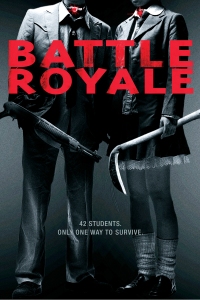 It’d be impossible not to compare “Battle Royale” with “The Hunger Games.” Conceptually, they’re identical. A tyrannical government has instated a law in which teenagers are forced to compete in a fight to the death in order to win their freedom.
It’d be impossible not to compare “Battle Royale” with “The Hunger Games.” Conceptually, they’re identical. A tyrannical government has instated a law in which teenagers are forced to compete in a fight to the death in order to win their freedom.
Though I’m more interested in their differences. After all, neither of these films is entirely original. “Battle Royale” draws on a long lineage of Japanese horror films and action movies, and”The Hunger Games” borrows liberally from the romance and themes of many YA novels.
In fact, where “The Hunger Games” concerns government oppression, individuality and coming of age, “Battle Royale” serves primarily as a character study, and in some ways it turns out to be a lot more fun.
In the film, it’s explained that the Battle Royale was instated as a response to the behavior of rebellious young people. More and more kids would be disobeying adults and in turn the government passed a law in which one classroom of 40-odd students would each year be put on an island and forced to fight to the death. “The Hunger Games” has a far more plausible explanation for their dystopia, but “Battle Royale” has fun with the concept and harbors some genuine bitterness and spite toward the youth and tests them with what it is to be an adult.
“It’s your own damn fault. You don’t respect adults,” says Kitano-sensei, the game master. “Life is a game; you fight for your survival!” While some quickly get killed in their panic and immaturity, and while others hide or some even choose to commit suicide and not play at all, those who do play the game learn respect and how to be an adult fairly quick. Take one scene in which a group of girls have holed up in a lighthouse with plans to travel across the island and make their escape. Everyone in the film is horny for one another, so after Shuya, the protagonist, ends up accidentally killing one of the girl’s crushes, she poisons his food and plots to kill him. The poison ends up in the hands of another of the girls, and in their short fused rage, untrusting nature and stupidity, the whole room gets left in a bloodbath, with Shuya completely in the dark as to how it happened.
The game confronts their feelings of uselessness and ability to make it in the real world. Here on the island as in society, the system is rigged against them, and many of them won’t figure out how to survive. After several of the kids die, the film cuts to black to display an epitaph, and at the film’s close it says, “Run! For all your worth.” It’s a message that isn’t shared by “The Hunger Games,” a belief that to live and make it out alive in this world, you have to embrace your future and your adulthood and prove your value and respect for the world.
That a message like that can be contained in a movie so generally shlocky and campy hints at why “Battle Royale” has become such a treasured cult film. It was released in 2000, but could be right at home in the ’80s or ’90s action genre. Kids dive in slow motion away from explosions, someone lodges a grenade in a severed head, and the film squirts gallons of fake blood, with red the only color breaking through the many grays and beiges. The film’s villain, a silent “transfer” student, makes for the perfect demon. He has a sport coat and great, untamed hair, with his eyeliner dripping down his cheek like a vampire as he steps out alive from some flaming wreckage. The film even has some neat, surreal dream sequences and a surprising heart as these kids profess their love for one another in dying arms.
“The Hunger Games” has a lot of things going for it, and it’s a great franchise for a reason. But it would be wrong to say it’s a “Battle Royale” knock-off, or vice versa. These are films with their own strengths, ideas and bloody charms.